A new, lineage specific, autoup-regulation mechanism for human glucocorticoid receptor gene expression in 697 pre-B-acute lymphoblastic leukemia cells
- PMID: 21084380
- PMCID: PMC3033051
- DOI: 10.1210/me.2010-0249
A new, lineage specific, autoup-regulation mechanism for human glucocorticoid receptor gene expression in 697 pre-B-acute lymphoblastic leukemia cells
Abstract
Glucocorticoid (GC) steroid hormones induce apoptosis in acute lymphoblastic leukemia (ALL). Autoup-regulation of human GC receptor (hGR) levels is associated with sensitivity to GC-mediated apoptosis. Among the major hGR promoters expressed in 697 pre-B-ALL cells (1A, 1B, 1C, and 1D), only promoters 1C and 1D are selectively activated by the hormone. Promoter 1B is unresponsive, and promoter 1A is down-regulated by dexamethasone (Dex) in 697 cells, whereas they are both up-regulated in CEM-C7 T-ALL cells. Autoup-regulation of promoter 1C and 1D in 697 cells requires sequences containing GC response units (GRUs) (1C GRU, -2915/-2956; 1D GRU, -4525/-4559) that were identified previously in CEM-C7 cells. These GRUs potentially bind GR, c-myeloblastosis (c-Myb), and E-twenty six (Ets) proteins; 697 cells express high levels of c-Myb protein, as well as the E-twenty six family protein members, PU.1 and Spi-B. Dex treatment in 697 cells elevates the expression of c-Myb and decreases levels of both Spi-B and PU.1. Chromatin immunoprecipitation assays revealed the specific recruitment of GR, c-Myb, and cAMP response element-binding protein binding protein to the 1C and 1D GRUs upon Dex treatment, correlating to observed autoup-regulated activity in these two promoters. These data suggest a hormone activated, lineage-specific mechanism to control the autoup-regulation of hGR gene expression in 697 pre-B-ALL cells via steroid-mediated changes in GR coregulator expression. These findings may be helpful in understanding the mechanism that determines the sensitivity of B-ALL leukemia cells to hormone-induced apoptosis.
Figures

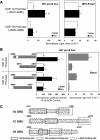

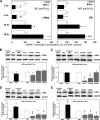
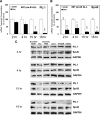
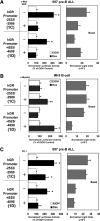
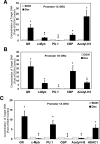

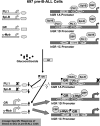
Similar articles
-
c-Myb interacts with the glucocorticoid receptor and regulates its level in pre-B-acute lymphoblastic leukemia cells.Mol Cell Endocrinol. 2012 Sep 25;361(1-2):124-32. doi: 10.1016/j.mce.2012.03.024. Epub 2012 Apr 10. Mol Cell Endocrinol. 2012. PMID: 22516378 Free PMC article.
-
c-Myb and members of the c-Ets family of transcription factors act as molecular switches to mediate opposite steroid regulation of the human glucocorticoid receptor 1A promoter.J Biol Chem. 2005 Dec 30;280(52):43264-71. doi: 10.1074/jbc.M508245200. Epub 2005 Nov 1. J Biol Chem. 2005. PMID: 16263717
-
A conserved molecular mechanism is responsible for the auto-up-regulation of glucocorticoid receptor gene promoters.Mol Endocrinol. 2008 Dec;22(12):2624-42. doi: 10.1210/me.2008-0157. Epub 2008 Oct 22. Mol Endocrinol. 2008. PMID: 18945813 Free PMC article.
-
Steroid-responsive sequences in the human glucocorticoid receptor gene 1A promoter.Mol Endocrinol. 2004 Apr;18(4):912-24. doi: 10.1210/me.2003-0157. Epub 2004 Jan 29. Mol Endocrinol. 2004. PMID: 15044598
-
How glucocorticoid receptors modulate the activity of other transcription factors: a scope beyond tethering.Mol Cell Endocrinol. 2013 Nov 5;380(1-2):41-54. doi: 10.1016/j.mce.2012.12.014. Epub 2012 Dec 23. Mol Cell Endocrinol. 2013. PMID: 23267834 Review.
Cited by
-
Heregulin negatively regulates transcription of ErbB2/3 receptors via an AKT-mediated pathway.J Cell Physiol. 2014 Nov;229(11):1831-41. doi: 10.1002/jcp.24637. J Cell Physiol. 2014. PMID: 24692179 Free PMC article.
-
A facile, branched DNA assay to quantitatively measure glucocorticoid receptor auto-regulation in T-cell acute lymphoblastic leukemia.Chin J Cancer. 2012 Aug;31(8):381-91. doi: 10.5732/cjc.012.10044. Epub 2012 Jun 26. Chin J Cancer. 2012. PMID: 22739263 Free PMC article.
-
Ectopic microRNA-150-5p transcription sensitizes glucocorticoid therapy response in MM1S multiple myeloma cells but fails to overcome hormone therapy resistance in MM1R cells.PLoS One. 2014 Dec 4;9(12):e113842. doi: 10.1371/journal.pone.0113842. eCollection 2014. PLoS One. 2014. PMID: 25474406 Free PMC article.
-
c-Myb interacts with the glucocorticoid receptor and regulates its level in pre-B-acute lymphoblastic leukemia cells.Mol Cell Endocrinol. 2012 Sep 25;361(1-2):124-32. doi: 10.1016/j.mce.2012.03.024. Epub 2012 Apr 10. Mol Cell Endocrinol. 2012. PMID: 22516378 Free PMC article.
-
Epigenetic alteration by DNA-demethylating treatment restores apoptotic response to glucocorticoids in dexamethasone-resistant human malignant lymphoid cells.Cancer Cell Int. 2014 Apr 23;14:35. doi: 10.1186/1475-2867-14-35. eCollection 2014. Cancer Cell Int. 2014. PMID: 24795534 Free PMC article.
References
-
- Pui CH, Robison LL, Look AT 2008 Acute lymphoblastic leukaemia. Lancet 371:1030–1043 - PubMed
-
- Nanni P, Nicoletti G, Prodi G, Galli MC, De Giovanni C, Grilli S, Lollini PL, Gobbi M, Cavo M, Tura S 1982 Glucocorticoid receptor and in vitro sensitivity to steroid hormones in human lymphoproliferative diseases and myeloid leukemia. Cancer 49:623–632 - PubMed
-
- Gaynon PS, Carrel, AL 1999 Glucocorticosteroid therapy in childhood acute lymphoblastic leukemia. Adv Exp Med Biol 457:593–605 - PubMed
-
- Pui CH, Evans, WE 2006 Treatment of acute lymphoblastic leukemia. N Engl J Med 354:166–178 - PubMed
Publication types
MeSH terms
Substances
Grants and funding
LinkOut - more resources
Full Text Sources
Miscellaneous

